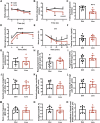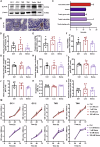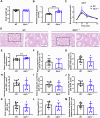GLP-1 receptor agonists show no detrimental effect on sperm quality in mouse models and cell lines
- PMID: 40347306
- PMCID: PMC12289847
- DOI: 10.1007/s12020-025-04245-4
GLP-1 receptor agonists show no detrimental effect on sperm quality in mouse models and cell lines
Abstract
Purpose: Glucagon-like peptide-1 receptor (GLP-1R) agonists exert multiple beneficial effects. However, their effects on reproduction system are controversial. Here, we aimed to investigate their effects on male reproduction and provide safety evidence for future clinical use.
Methods: Male diabetic mice and aged mice were treated with liraglutide or vehicle, and sperm concentration and motility were assessed. The expression and location of GLP-1R in testicular tissues and in four testicular cell lines (spermatogonia, spermatocytes, Leydig cells, and Sertoli cells) were detected. Cauda epididymis and testicular cells were treated with liraglutide, semaglutide or vehicle, and sperm motility and cell proliferation were detected to determine the direct effect of GLP-1R agonists. Global Glp1r knockout mice were constructed, and testicular morphology, sperm concentration and motility were detected to confirm the effects of GLP-1R signaling on male reproduction.
Results: Liraglutide significantly reduced blood glucose levels, but did not improve sperm parameters in diabetic mice. No significant differences were observed between liraglutide and control group in aged mice. GLP-1R was expressed in testicular tissues and all four cell lines, with the highest expression in Leydig cells. Liraglutide or semaglutide had no impacts on sperm count and motility in vitro, and had no effects on cell proliferation in four cell lines. The Glp1r knockout mice exhibited higher blood glucose levels and preserved normal testicular morphology, but their sperm concentration was higher than that in wildtype mice.
Conclusion: GLP-1R agonists have no detrimental effect on sperm concentration and motility in vivo and in vitro, while GLP-1R absence increase the sperm concentration.
Keywords: Aging; Diabetes; Glucagon-like peptide-1; Sperm concentration; Sperm motility.
© 2025. The Author(s).
Conflict of interest statement
Compliance with ethical standards. Ethics approval and consent to participate: The study protocol was reviewed and approved by the Ethics Committee of Peking University (Approval No. PUIRB-LA2023522). Conflict of interest: The authors declare no competing interests.
Figures




Similar articles
-
Glucagon-like peptide 1 (GLP-1) receptor agonists for people with chronic kidney disease and diabetes.Cochrane Database Syst Rev. 2025 Feb 18;2(2):CD015849. doi: 10.1002/14651858.CD015849.pub2. Cochrane Database Syst Rev. 2025. PMID: 39963952
-
Dipeptidyl-peptidase (DPP)-4 inhibitors and glucagon-like peptide (GLP)-1 analogues for prevention or delay of type 2 diabetes mellitus and its associated complications in people at increased risk for the development of type 2 diabetes mellitus.Cochrane Database Syst Rev. 2017 May 10;5(5):CD012204. doi: 10.1002/14651858.CD012204.pub2. Cochrane Database Syst Rev. 2017. PMID: 28489279 Free PMC article.
-
Prognostic impact of glucagon-like peptide-1 receptor (GLP1R) expression on cancer survival and its implications for GLP-1R agonist therapy: an integrative analysis across multiple tumor types.Geroscience. 2025 Jun;47(3):4413-4427. doi: 10.1007/s11357-024-01494-5. Epub 2025 Jan 8. Geroscience. 2025. PMID: 39777709 Free PMC article.
-
Effects of glucagon-like peptide-1 receptor agonists on weight loss: systematic review and meta-analyses of randomised controlled trials.BMJ. 2012 Jan 10;344:d7771. doi: 10.1136/bmj.d7771. BMJ. 2012. PMID: 22236411 Free PMC article.
-
Antioxidants for male subfertility.Cochrane Database Syst Rev. 2014;(12):CD007411. doi: 10.1002/14651858.CD007411.pub3. Epub 2014 Dec 15. Cochrane Database Syst Rev. 2014. Update in: Cochrane Database Syst Rev. 2019 Mar 14;3:CD007411. doi: 10.1002/14651858.CD007411.pub4. PMID: 25504418 Updated.
References
-
- Y. Cao, Z. Jin, Y. Xi, J. Cheng, Z. Fang, Q. Zhao et al., Roles of ferroptosis in type 1 diabetes induced spermatogenic dysfunction. Free Radic. Biol. Med 214, 193–205 (2024). 10.1016/j.freeradbiomed.2024.02.006. - PubMed
-
- M.L. Eisenberg, S.C. Esteves, D.J. Lamb, J.M. Hotaling, A. Giwercman, K. Hwang et al., Male infertility. Nat Rev. Dis. Prim. 9, 49 (2023). 10.1038/s41572-023-00459-w. - PubMed
-
- D.F. Carrageta, B. Guerra-Carvalho, M.A. Spadella, M. Yeste, P.F. Oliveira, M.G. Alves, Animal models of male reproductive ageing to study testosterone production and spermatogenesis. Rev Endocr. Metab. Disord. 23, 1341–1360 (2022). 10.1007/s11154-022-09726-9. - PubMed
-
- B. Kreymann, G. Williams, M.A. Ghatei, S.R. Bloom, Glucagon-like peptide-1 7-36: a physiological incretin in man. Lancet 2, 1300–1304 (1987). 10.1016/s0140-6736(87)91194-9. - PubMed
MeSH terms
Substances
Grants and funding
LinkOut - more resources
Full Text Sources
Medical

